Who is Ratonhnhaké:ton? He's the son of a British father, raised by his Mohawk mother and caught in a struggle between his own people and the colonists spreading through the American Northeast. He's an assassin who, like those before him, believes in the people's right to be free and make their own choices. He's also known as Connor, and he stars in Assassin's Creed III, the most thematically rich game in this ambitious and freewheeling series.
In some respects, Connor is a vessel for ideas more than a force of nature in his own right, though few heroes could hope to outshine the charming and worldly star of Assassin's Creed II, Ezio Auditore. Noah Watts' unsure voice acting keeps Connor at arm's length, emotionally--though in some respects, the distance is appropriate, given Connor's uncertain path through a complex political landscape. It's the time of the American Revolution, and Connor finds himself a key figure on and off the battlefield. He fires cannons, commands troops, and jams his tomahawk into loyalist flesh. He rides with the delightful Paul Revere and conspires with Samuel Adams, thus allowing you to participate in some of the time period's most renowned events: the Boston Tea Party, the Battle of Bunker Hill, and so forth. Assassin's Creed games are well known for their incredible attention to historical detail, and Assassin's Creed III is no exception. Major and minor figures are depicted; the cities of Boston and New York are exquisitely re-created; and even minutiae like the lines of The Beggar's Opera are presented with fine accuracy.
Yet Assassin's Creed III is less about history and more about the broader themes of the franchise. The Assassin vs. Templar conflict deepens here. You've heard the Templar point of view before, often via the soliloquies of dying men who pleaded the good intentions of a philosophy that nonetheless paved an apparent road to hell. Now, the truth, such as it is, isn't so cut-and-dried. You hear the sincere and convincing words of the men you've assumed represent the wrong side of morality, and must wonder: are the ideas of good and bad so absolute after all? Are the men you cradle in your arms as they gasp their dying breaths necessary casualties, or do they whisper ideas worth hearing and understanding? As one character insists, "There is no one path through life that's right or fair."
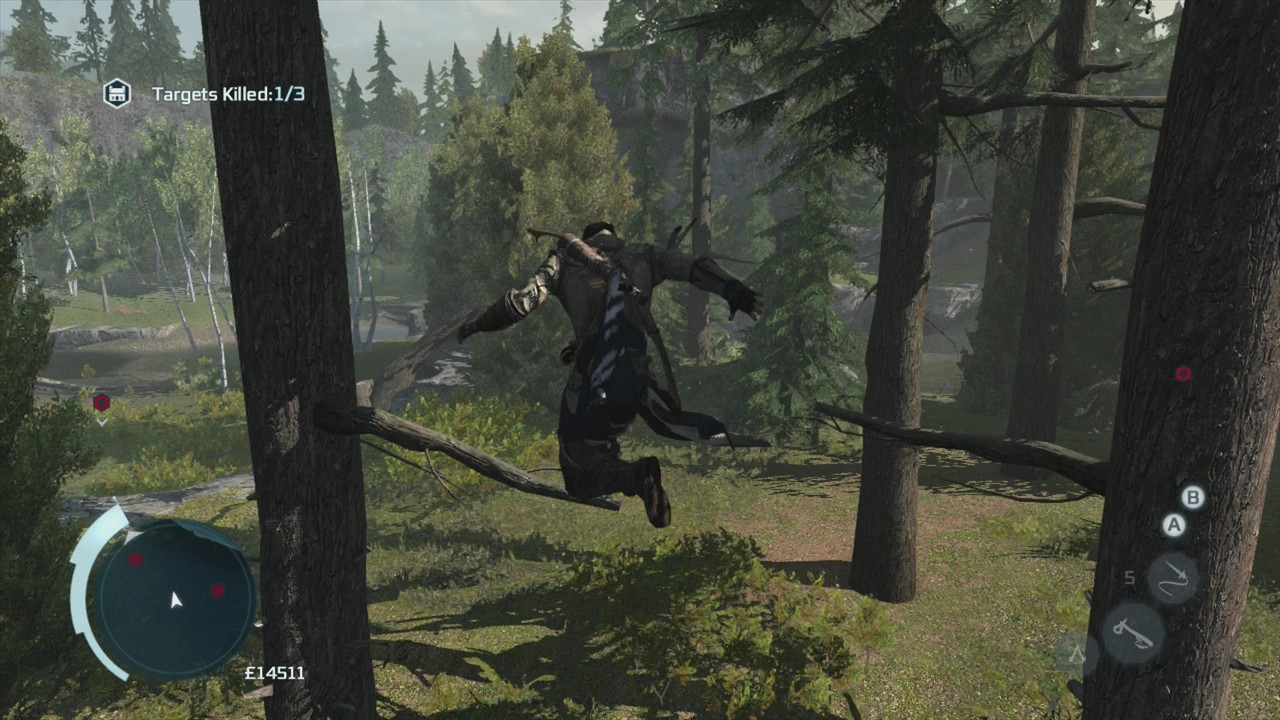
Of course, Connor's dilemma is one of the past; in the present day, series constant Desmond Miles plays his own role, making his legend by carving his way through the here and now. Connor fights for the rights of his people; Desmond holds the fate of the world in his hands. Assassin's Creed III draws important parallels between the two men, both of whom navigate a thorny relationship with an estranged father. Surprisingly, given the series' past, Desmond's story tugs at the heart, not because of his newfound relationship with his aloof father, but because he learns more of the First Civilization, and their futile attempts to ward off the disaster that annihilated them.
The Desmond portions are even more fleshed out than before, allowing the former bartender to at last exercise his own stealth, parkour, and assassination skills, hinting at the possibility of full-fledged modern-day adventuring--though never quite arriving there. There does come an important revelation, however: the typically surprising finale that leaves you scratching your head, and in this case, forces you to consider an unpleasant truth about the nature of humanity. The finale lacks punch and falls short of Assassin's Creed II's jaw-dropping conclusion. But the inconclusive ending is designed to have you guessing, and you will ponder the implications over and over, trying to weave a tapestry of truth out of the conspiracies that have always buoyed the series' self-serious stories.
It takes time to reach that conclusion, or indeed, to experience the parkour flights of fancy that represent Assassin's Creed III at its best. In fact, it takes time for you to even meet its hero, though it's better to discover just how the game handles that introduction on your own. Suffice it to say: the opening hours are unexpectedly protracted as you discover that this is, indeed, a different kind of Assassin's Creed. It's no less joyous, once the stops are ultimately pulled out, but the game takes its time, trusting you to be patient with a slow-paced prologue that is concerned more with establishing tone and backstory than with allowing you free rein of its bustling cities.

As you play that opening, it's hard not to wonder: when does the fun stuff come? In retrospect, however, the slow pace makes sense. This is the biggest game in the series by a notable margin, and once the beginning is put in context, you'll be glad for the character development, and glad that you had time to discover some of what makes Assassin's Creed III different from its predecessors. You'll also be glad of the narrative twist that reshapes your expectation as you transition into the larger part of the game, reminding you that the series has rarely shied from playing with your mind.
Just what are the most notable gameplay differences in Assassin's Creed III? Well, the parkour has changed, for starters. The control scheme is simpler, but this change is ultimately sensible considering it streamlines Connor's singular ability to bound from tree to tree just as brilliantly as he can scale walls and leap across roofs.
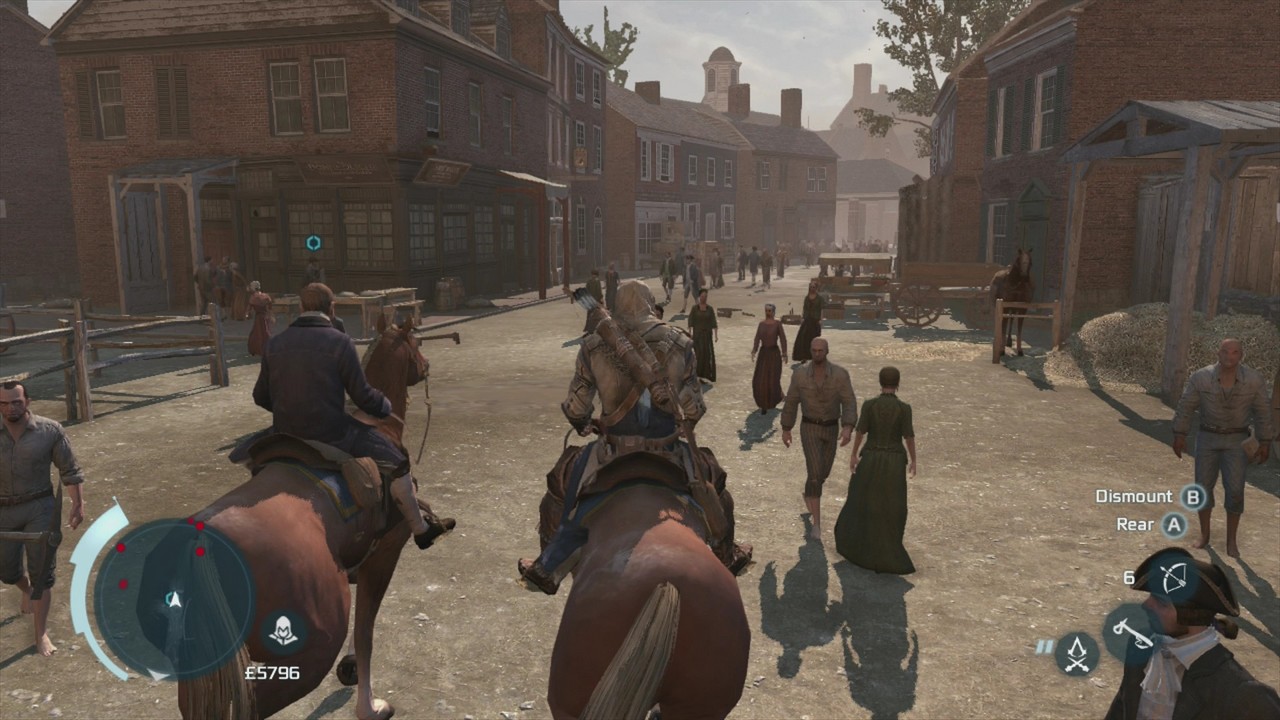
It takes some time to get accustomed to the rhythms of tree-jumping, which can be finicky and unpredictable. Though you can more or less speed across Boston and New York as if the buildings were your own personal jungle gyms, when seeking to fly through the frontier, you must keep your eyes peeled for the telltale signs of a climbing opportunity. You use a fallen tree much as a plane uses an airport runway, gaining momentum and then soaring. There are those moments that slow you down; you might not be positioned quite right and thus swing impotently rather than flow smoothly toward the next branch. You might even make an inadvertent leap of faith into a leaf pile below that you didn't notice until the game decided you were trying to fall into it. But then there are those moments in which it all comes together, and you fly with abandon across the unique architecture of the forest canopy.
While the trees that dot the main cities are sometimes there for climbing, most of the elms and birches you crisscross are within the frontier, as well as in the broad patch of land that functions as your homestead. The homestead is to Connor what Monteriggioni was to Ezio, but on a much broader scale. Your manor isn't fully your own--it belongs to Achilles Davenport, a former assassin who one day finds a persistent Ratonhnhaké:ton knocking at his door. Achilles is one of Assassin's Creed III's best characters, and it's a pity he doesn't get more screen time; his tough love balances Connor's naivete, but the bulk of Connor's training time is left only to your imagination.
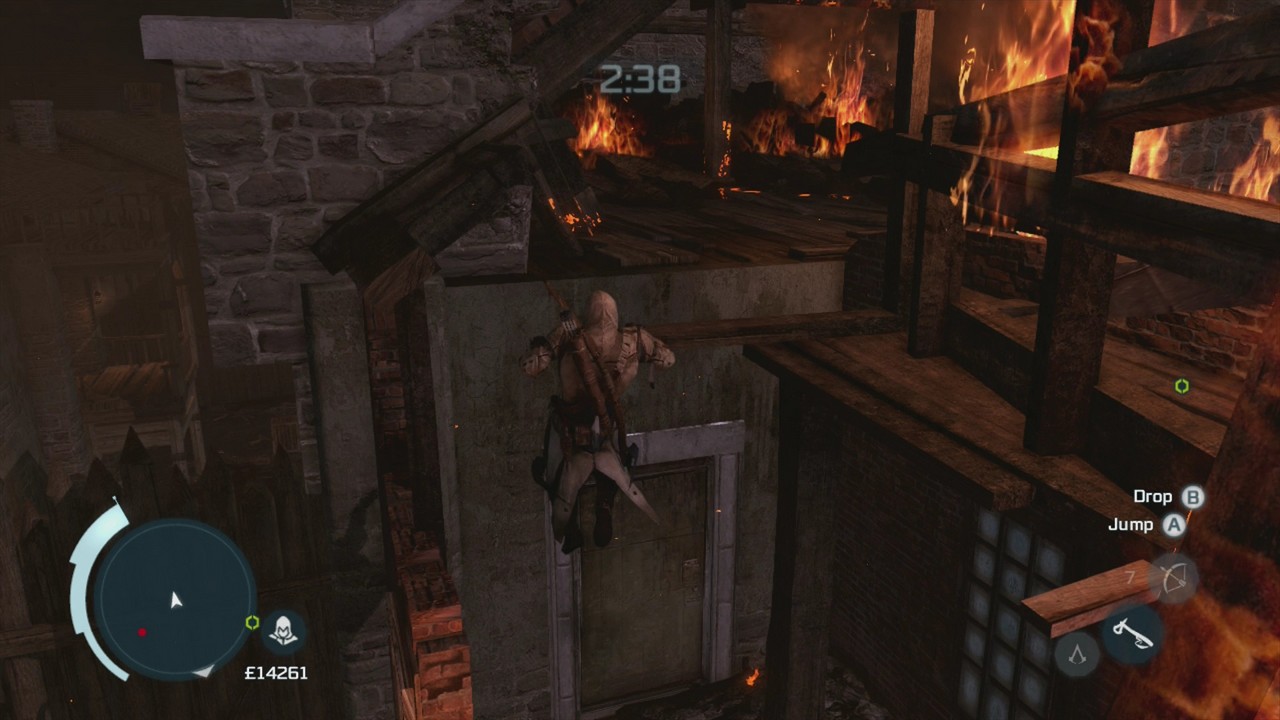
The homestead is more than just a place for Connor and Achilles to banter and argue--it's the central element of Assassin's Creed III's economy. Like much of Assassin's Creed III, the homestead-focused facets are purely optional, yet they are worth exploring. The homestead is about building: building a village, building a future, and building relationships. By performing related missions, you befriend craftspeople, gatherers, hunters, and more, all of whom might find a place on the homestead. In turn, they can craft items that you sell via caravan for profit. (You discover recipes in treasure boxes throughout the world, some of which must be opened by performing a lock-picking minigame.) The homestead missions are varied, having you protect a miner as he scavenges for ore, search Boston for a drunken doctor, or break up a fisticuffs. In turn, your income grows, you meet new and interesting characters, and the homestead becomes, well, a home.
Meanwhile, out on the frontier, you can supplement your storehouse by trapping or attacking wild animals and then skinning them, leaving their carcasses behind. There's rarely a pressing reason to go hunting, just as there has never been a pressing reason to use smoke bombs to facilitate an easy escape when you can just dispatch your foes with a sword or an axe. But there's something enjoyably bizarre about perching on a tree branch and then assassinating a bunny rabbit from above. You can examine various clues--the signs of a foraging deer, for instance--to identify the location of a nearby animal. Hunting isn't a necessary aspect of Assassin's Creed III, though, but more of a toy for tinkering with, unless you grow deeply invested in the homestead's economy.
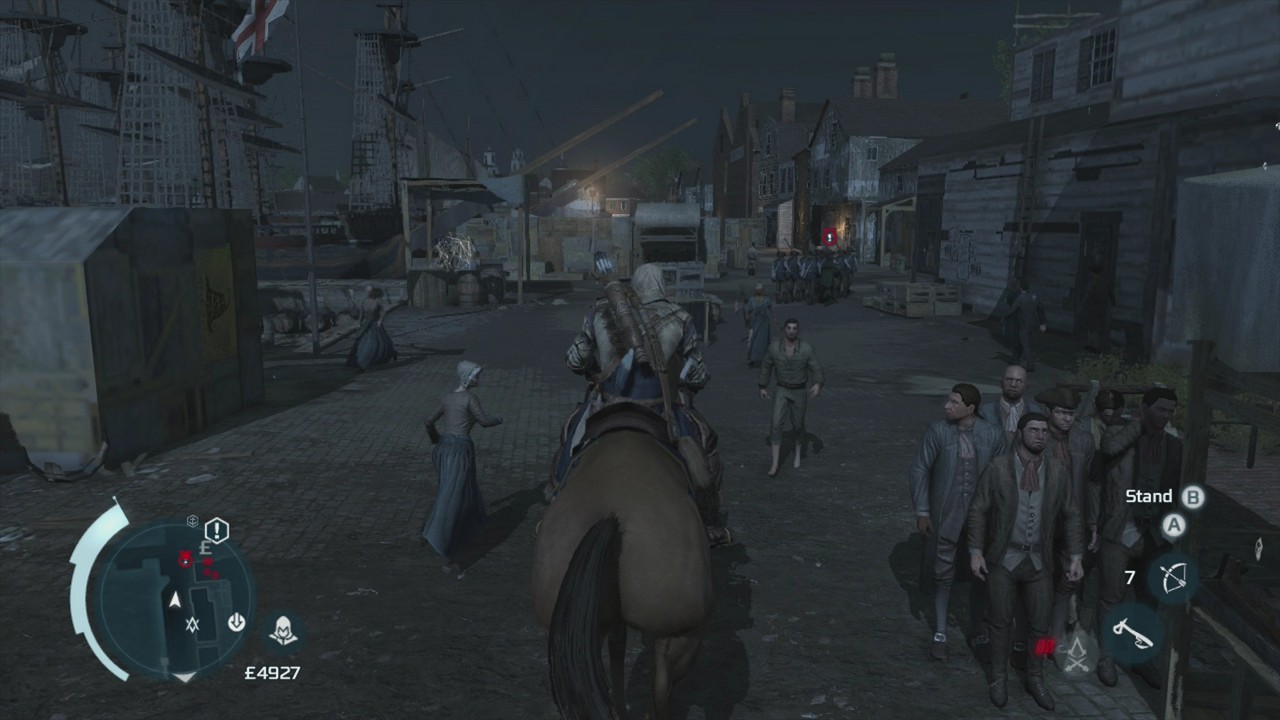
You stumble upon guarded redcoat convoys to attack and loot out on the frontier, but cities are home to most of the action. Even outside of story missions, there's plenty to do in Boston and New York. Ben Franklin's missing almanack pages float in the sky, giving you a reason to take to the rooftops and prance about. (You're rewarded with excerpts from the famous Poor Richard's Almanack, which are full of clever wordplay.) Liberation missions have you rescuing townsfolk from British soldiers, burning diseased blankets, and protecting farmers from rampaging redcoats. In almost every location, frontiersmen tell tall tales of flying saucers and the sasquatch, and the truths you discover if you follow these leads make for an interesting thematic twist.
Your exploits have you making direct contact with guards and soldiers, though combat has been tweaked so that it resembles that of Batman: Arkham Asylum more than ever. You counter by pressing the proper button when an indicator appears over an enemy's head, and you no longer have to manage a lock-on mechanic. Battles are fluid and bloody, as Connor chops, slashes, and somersaults about, though as always, you couldn't accuse combat of being especially difficult. Musketeers take aim, but if there's a nearby enemy, you can grab him and use him as a human shield, which protects you and dispatches a guard in a single move. Notably, Assassin's Creed III abandons health items and embraces regenerating health, though considering the previous few games' abundance of health items, there's no appreciable loss--or gain--of challenge.
There are chances to go stealthy too; Connor crouches automatically in tall grass, and can even press against corners and peek around. Hiding in grass is handy a number of times, though peeking around corners is an inconsistent proposition, since not every object has a "peekable" edge. In fact, inconsistencies occur within the parkour elements too, particularly out on the frontier, where you can scale rocky cliffs. Some cliffsides you can climb, and some you can't, even when it seems you should be able to grab hold and begin your ascent. And several chase sequences seem designed to annoy, such as one near the end of the game in which keeping up with your quarry is only frustrating and never fun.
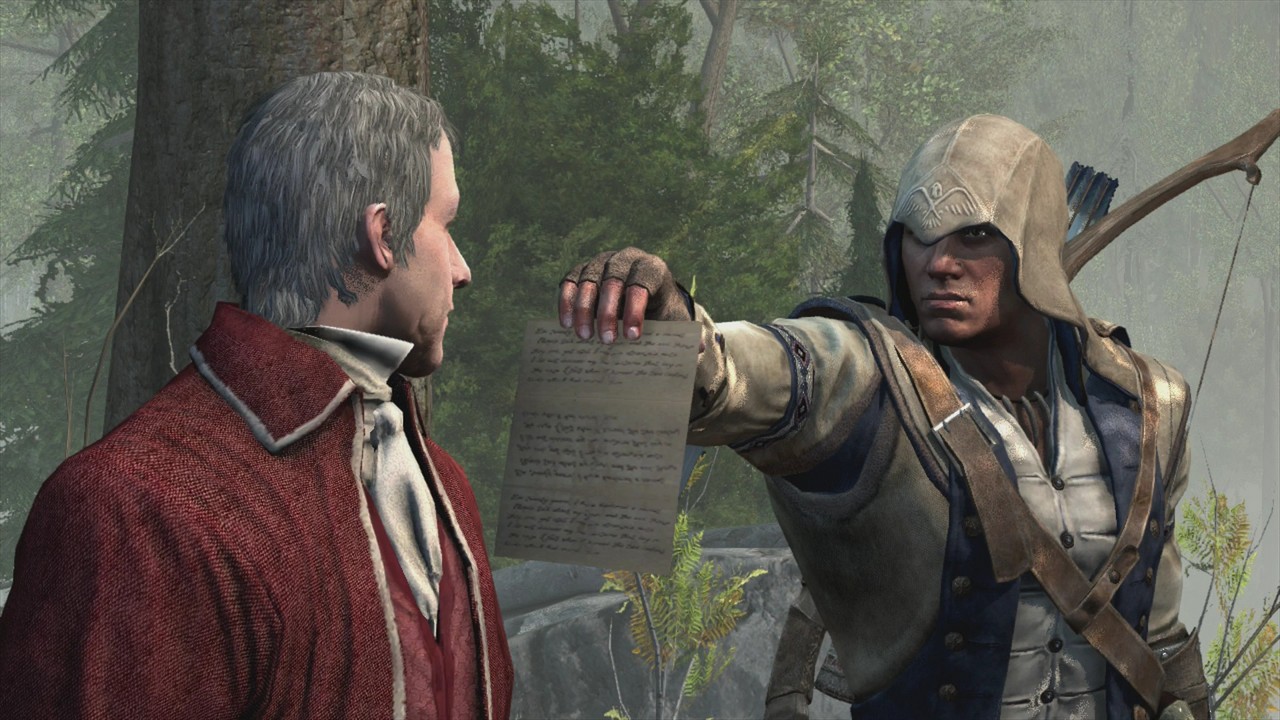
But the inconsistencies run deeper than these little inconveniences. Assassin's Creed III is the buggiest game in the series, with glitches running the gamut from minor messiness to bigger foibles. Animals running into rocks and then continuing to run in place is silly but inconsequential. Ditto for minor technical snafus: the occasionally problematic combat camera angles, distracting animation hitches, citizens that suddenly pop into view, and so forth. But then there's that bear that could clip into a cave wall and render a side mission incompletable, or that scripting error that allows you to open a door by standing on the roof above, bypassing a battle and thus causing improper overlapping dialogue when you leave the building. There's an air of sloppiness here that was kept to a minimum in previous installments.
Assassin's Creed III's pure breadth offsets these issues to a great degree, however. The expanses are vast, and the atmosphere is palpable. In place of the golden aura of previous games is a more muted look, in keeping with the muddy trails of the wilderness and the rustic homes that sometimes line them. In New York, you see the remnants of the great fire of 1776, the ravages of which contrast greatly with the sunny opulence of Assassin's Creed II's Venice, and the Constantinople of Assassin's Creed: Revelations. It's hard not to admire the fantastic animations as Connor scales walls and trees, his hands authentically grabbing crevasses and his feet resting on outcroppings.
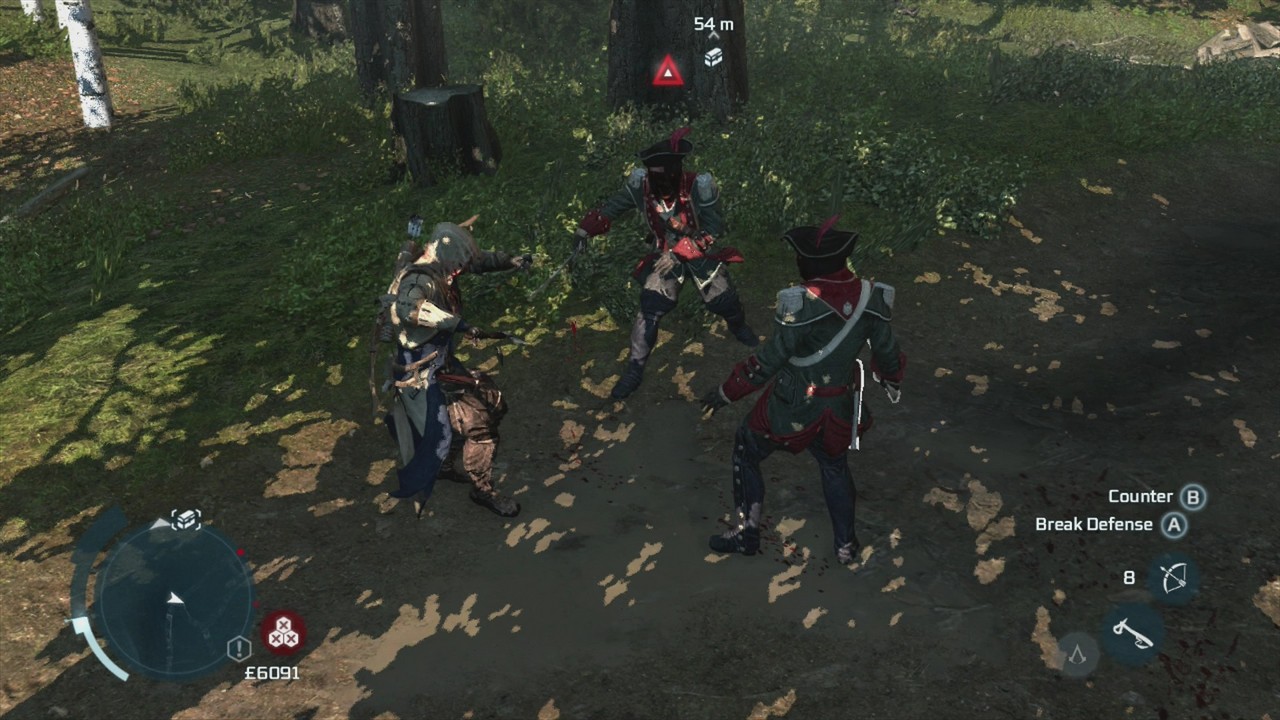
The presentation shines when Connor goes to sea, as well. Connor is not just an assassin but a captain too, and a series of (usually) short side missions have you getting behind the helm and facing the tumult of the open ocean. The visual details are marvelous, capturing the controlled chaos of an eager crew hard at work, and impressing upon you the madness of the roiling waves, which you can never hope to tame. Sailing is evenly paced but often super tense as you maneuver into just the right spot to unleash cannons on the ships that endanger you, while avoiding the cannonballs that whoosh your way. You occasionally finalize sea battles by ramming enemy ships and boarding them, finishing off the crew in a bloody melee showdown. You can purchase ship upgrades, some of which are very expensive and might have you heading back to the homestead to finagle ways of enhancing your income.
The multiplayer first introduced in Assassin's Creed: Brotherhood makes a return, and with it, the rising tension and brutal release of assassinating other players while simultaneously avoiding the watchful eyes of your opponents. There are a number of modes in which to exercise your skill, but in most cases, the goal is to blend into the crowds, preferably with groups including carbon copies of your own character model. And as before, you level up and earn skills to perform in battle, like throwing poison darts, as well as various passive perks. Unlike before, however, you can spend real money on various upgrades as well as in-game currency. There are loads of customization options in front of you, and it's tempting to drop the cash, whether it be to change various characters' looks or to feel like a greater asset to your team. It's one of the most extensive attempts to monetize a retail game ever seen, and comes across as particularly shameless, even in light of similar schemes in other games, such as Mass Effect 3.
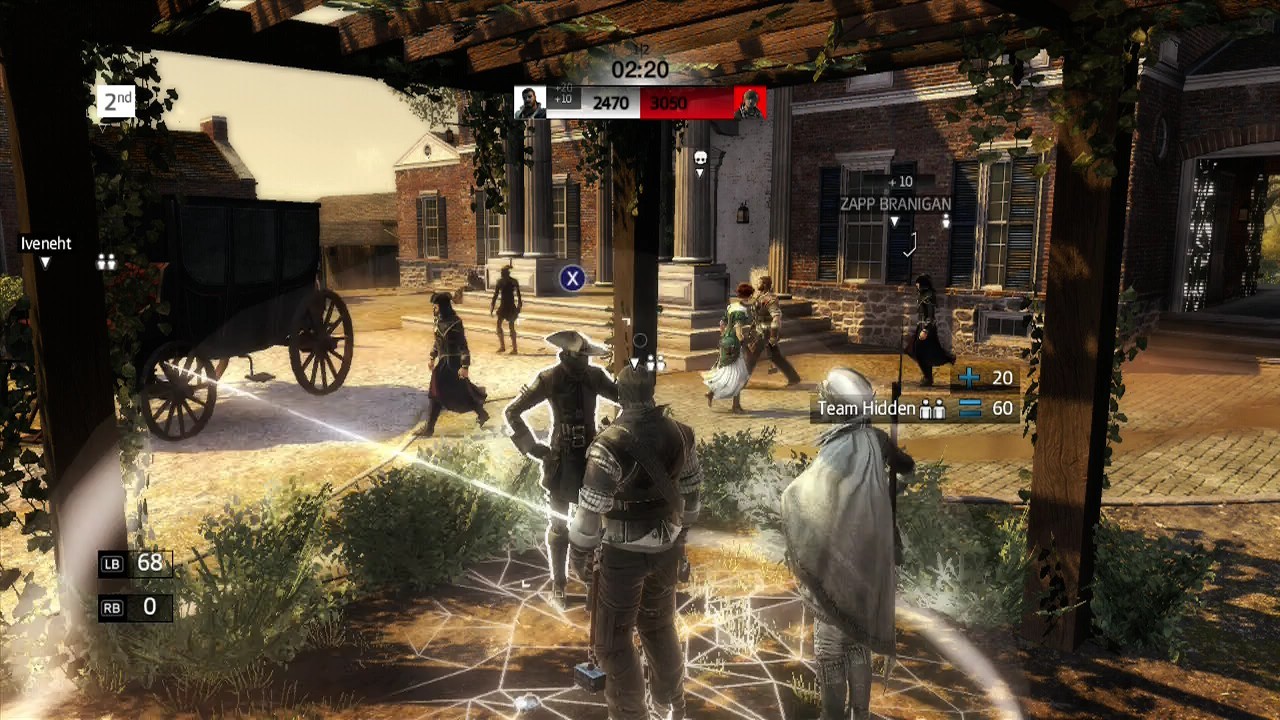
Nevertheless, there's great satisfaction in pulling off a silent kill--and great heartache in axing a civilian to death because you mistake her for an opponent. If you feel more cooperative than competitive, you can try Assassin's Creed III's Wolfpack mode, which takes the competitive mechanics but pits up to four players against the AI and pushes you to rack up points as quickly as you can to add seconds to the countdown timer and progress from one sequence to the next. It's an action-focused mode in a franchise whose multiplayer modes usually rely more on building suspense, though the pressure of the countdown timer gives the mode a welcome sense of urgency.
Assassin's Creed III is a big game that gives you a lot to do, some of which is fleshed out relatively well, and some of which isn't. It is not, however, content to rest on the series' laurels. It takes chances with its opening, with its story, and with its characters. It expands the series' gameplay in enjoyable and sensible ways. As with many ambitious games, not every arrow fired hits the bull's-eye, yet this big, narratively rich sequel is easy to get invested in. Other games stimulate emotion with manipulative music and teary monologues; Assassin's Creed III rouses your mind and your heart by giving you a glimpse into its characters' souls and letting you judge them on their own merits.